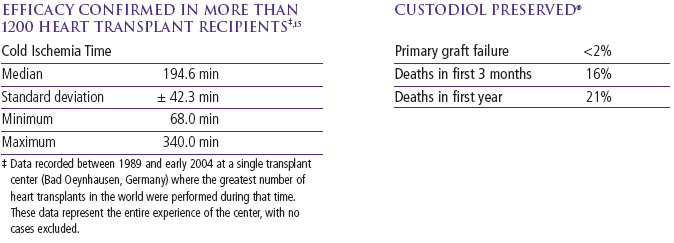
- No unexpected adverse events in clinical studies of heart transplantation15
- Low potassium content allows direct release into patient’s circulatory system.9
- Buffered with histidine and histidine HCI
- Doubles buffering capacity of transplanted organs, which slows drop of pH3
- Moderates damaging reductions of pH even at higher storage temperatures3
- Developed originally as a cardioplegic,+ CUSTODIOL® has been used in almost 2 million cardiac procedures1

- In an experimental study, canine hearts preserved in CUSTODIOL® and Celsior solutions were evaluated for post-ischemic functions, in particular, capacity for energy metabolism (indicated by the presence of the energy-rich phosphates ATP and ADP§) and return to normal cardiac rhythm (as measured by occurrence of arrhythmia).16
- Researchers found that hearts preserved in CUSTODIOL® contained significantly more energy-rich ATP 12 hours after ischemia than hearts preserved in Celsior (P<0.05). CUSTODIOL® – treated hearts had much higher ATP / ADP ratios when measured at 8 hours (P<0.01) and 12 hours (P<0.05) postischemia.
- CUSTODIOL ® – treated canine hearts had a lower rate of arrhythmic beats in the first 10 minutes following reperfusion after 8 to 12 hours of ischemia than hearts treated in Celsior.
Celsior is a registered trademark of Genzyme Corporation.
+Not approved for this use in the United States.
§ATP-adenosine triphosphate; ADP-adenosine diphosphate.



